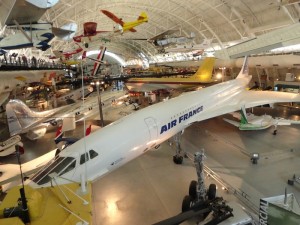Smithsonian National Air and Space Museum
Simply put, the Smithsonian National Air and Space museum is my favorite museum in the world. Recently I made it out to visit the Steven F. Udvar-Hazy Center which is the companion facility to the air and space museum on the national mall. The Steven F. Udvar-Hazy Center was built to house the thousands of aviation and space artifacts that do not fit into the building on the national mall. Unfortunately, since the center is inconveniently located outside of DC next to the Dulles Airport, many people miss this facility which houses some of the best exhibits. Many engines, helicopters, ultra-lights, and experimental flying machines are on display in a museum setting, at the Steven F. Udvar-Hazy Center, for the first time. The variety of aircraft at the site ranges from decrepit world war II fighter jets to the Lockheed Martin SR-71 Blackbird, to the Space Shuttle Discovery. The variety, scale and quantity of the aircraft on display simply makes the Steven F. Udvar-Hazy Center one of the best museums in the world.
Space Shuttle Discovery
Human spaceflight is one of the great achievements of the modern age. Since the first venture into space by Soviet cosmonaut Yuri Gagarin in 1961, more than 500 men and women have flown in space, some staying months at a time. People have circled the Earth in small capsules and huge Space Shuttles. They have floated in open space, delivered satellites, conducted laboratory experiments, repaired space telescopes, and built a space station. Twenty-four men have flown to the Moon and back (three went twice), and twelve explored its landscape.

The Lockheed Marktin Blackbird is in the foreground with the Space Shuttle Discovery in the background beneath an American Flag.
Space shuttle Discovery takes its name from four British ships of exploration named Discovery, primarily HMS Discovery, one of the ships commanded by Captain James Cook during his third and final major voyage from 1776 to 1779. Discovery has flown more missions that nay other spacecraft. The space shuttle completely 39 missions over 27 years spending over 365 days in space and traveling nearly 150 million miles. Discovery was the shuttle that launched the Hubble telescope and performed the subsequent second and third Hubble service missions.
Lockheed Martin SR-71 Blackbird
No reconnaissance aircraft in history has operated globally in more hostile airspace or with such complete impunity that the SR-71, the world’s fastest jet-propelled aircraft. The Blackbird’s performance and operational achievements placed it at the pinnacle of aviation technology developments during the Cold War.
The Blackbird in the picture accrued about 2,800 hours of flight time during 24 years of active service with the US Air Force. On its last flight, March 6, 1990, Lt. Col. Ed. Yielding and Lt. Col. Joseph Vida set a speed record by flying from Los Angeles to Washington DC in 1 hour, 4 minutes and 20 seconds. They averaged 2,124mph (3,418 kilometers/hour). At the flights conclusion they landed at Washington Dulles International Airport and turned the plane over to the Smithsonian.
Concorde
Concorde is a retired turbojet-powered supersonic passenger airliner or supersonic transport. Concorde was jointly developed and produced by Aérospatiale and the British Aircraft Corporation. First flown in 1969, Concorde entered service in 1976 and continued commercial flights for 27 years. It was retired from service in 2003.
Disclaimer: Portions of the previous text are shamelessly copied from the Smithsonian National Air and Space Museum placards and website along with excerpts taken from linked wikipedia pages. All pictures are completely my own.
[wzslider]







